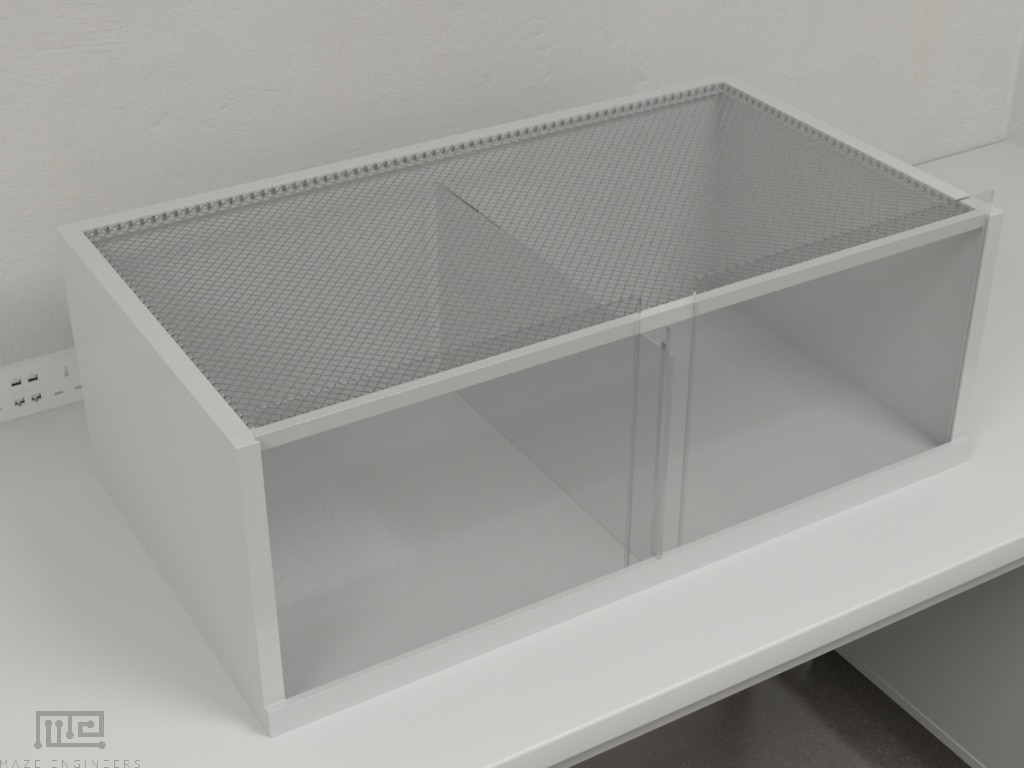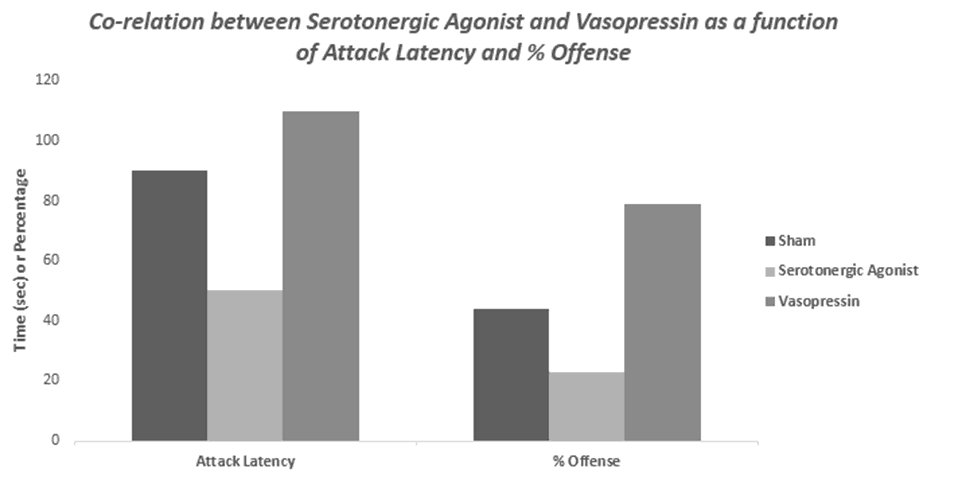Description
The Resident Intruder test is a chamber used for social defeat paradigms. Composed of a clear front of cage for video recording; opaque sides and back; wire top; lip on bottom to keep in bedding; easy to clean by spraying and wiping with 70% ethanol without losing clarity of front wall.
A sliding panel door in front is used to introduce and retreive rats; it can also be used to separate them if need be. A slot to insert a wire mesh dividing wall between the two halves of the cage. A fixture to allow water bottle and food tubes
Features
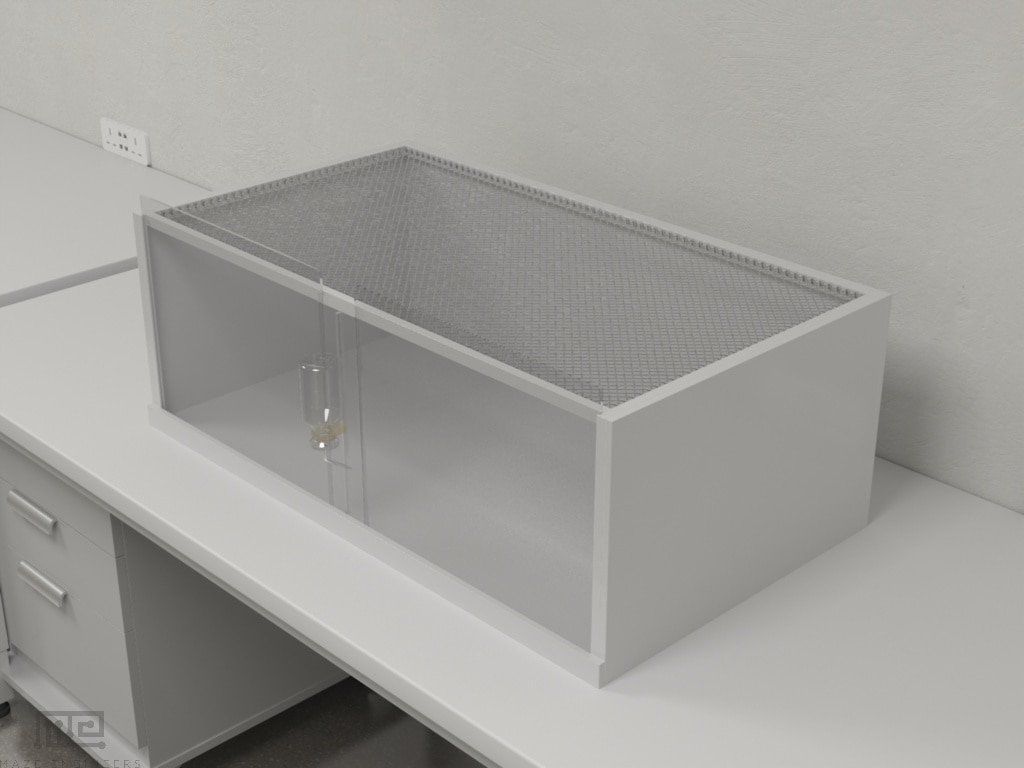
Accessories
Price & Dimensions
Mouse
$ 1890
Per Month- Length: 11 in
- Width: 19 in
- Height: 7 in
Rat
$ 2290
Per Month- Length: 21 in
- Width: 38 in
- Height: 14 in
Documentation
Introduction
The resident-intruder paradigm is a widely used model to assess aggressive behavior and its subsequent negative consequences such as social stress. Aggressive behavior can be considered as a highly functional form of social communication aimed at active control of the social environment (Koolhaas et al., 2013). The resident-intruder paradigm is a unique tool to understand different types of spontaneous aggressive behaviors in rodents in an environment that resemble their natural setting.
In the Resident-Intruder paradigm, social stress is investigated by subjecting animals to social defeat. For investigating the acute model of stress, one social defeat session is usually performed, but for investigating the chronic model of stress, the social defeat can be prolonged for a longer duration (more than one session).
It is a broadly applicable task as it can evaluate aggressive and defensive behaviors, social stress, the involvement of the HPA axis following a social defeat, the effects of pro-aggressive and anti-aggressive drugs. Furthermore, it has also led to the discovery of a novel neurochemical pathway.
This task is usually conducted in a territorial male resident rat or mice confronting an intruder of the same species. In this way, the paradigm is useful in eliciting both offensive and defensive aggression in animals under different influences and situations. Specifically, the paradigm has been useful in psychopharmacological studies on aggression (Olivier and Young, 2001).
Apparatus and Equipment
The resident-intruder apparatus consists of a chamber assembled from a material that makes sanitizing easy. The lateral sides, back, and the base of the chamber are opaque, and the top is made up of wire mesh. The front door is kept clear for optimal recording through video trackers such as Noldus Ethovision XT. The front door is provided with a sliding window that can be used to introduce and remove subjects.
Training Protocol
The aim of the resident-intruder is to assess a variety of aggressive behaviors (such as offensive and defensive aggressive behavior, violence, and social stress) and the role of HPA axis followed by social defeat in rodents.
Pre-testing/Habituation Phase:
In the Resident-Intruder test, territoriality is considered imperative. During the pre-testing period, territoriality is simulated in male rodents by the presence of females, sexual experience (Barnett, 1975 and Albert et al., 1988), and olfactory cues. The bedding of the cage is not cleaned to let the resident establish its own territory and the intruder to perceive that it is in the home cage of the resident.
The result of this territoriality is that the resident is likely to attack any unfamiliar males intruding its home cage. This makes it possible to study offensive aggression by using the resident as the experimental animal. One hour before the test, the companion female is removed from the resident cage. After this is done, the testing phase is started.
Testing/Observation Phase:
The optimal time to carry out the testing phase is during the rodents’ peak activity period which is usually the dark phase. At the start of the experiment, an unfamiliar male (intruder) should be introduced into the home cage of the resident. The intruder should be slightly smaller than the resident and should not be used in any experiment with the same resident before. With the aid of a light sensitive video camera such as Noldus Ethovision XT, the behavior of the resident is recorded. In general, when resident males encounter an unfamiliar male intruder in their territory, the bout may result (Miczek, 1979).
Testing can be performed once or twice a day; with each test period running for 10 minutes. However, the experimenter may continue the test for 10 minutes after the first attack. The level of aggressive behavior usually increases across the first few tests but remains constant after three to four tests. At the end of the test, the intruder male is removed from the cage while the resident male is reunited with its companion female.
The data collected from the recordings can be used to investigate several behaviors through observable parameters, and a detailed quantitative account of offensive (resident) and defensive (intruder) aggression can be obtained (Koolhaas et al., 2013).
Evaluation of offensive aggressive behavior
For offensive aggressive behavior, the resident male is observed by taking the duration and frequency of parameters such as attack latency (the time between the introduction of the intruder and the first clinch attack), shift towards the intruder, social exploration, anogenital sniffing, rearing, chases, keep down, clinch attack, upright posture, lateral threat, non-social exploration and rest or inactivity.
Evaluation of defensive behavior
To assess defensive behavior, well trained, highly aggressive, non-violent resident males are usually selected. The duration and frequency of behavioral parameters such as submission latency, submissive posture, shifting away from the resident male, flight, defensive upright posture, freezing, non-social explore and rearing are determined in the intruder.
Evaluation of Violence
For behavior depicting violence, the same protocol is followed both for the residents and intruders. Behavioral parameters like attack latency, the ratio between the frequencies of lateral threats and clinches, bites at target sites, and behavior of the intruder in a new environment are observed. A very short latency is the first indicator of violence.
Evaluation of the involvement of HPA axis following social defeat
In this model, the subjects (both aggressive and submissive) usually exhibit increased serum level of corticosterone after each social defeat, which is indicative of the enhanced activity of the HPA (hypothalamic–pituitary–adrenal) axis. (De Miguel et al., 2011)
Evaluation of Pro-aggressive and Anti-aggressive actions
This paradigm can also be utilized to evaluate the actions of pro-aggressive agents such as benzodiazepine and alcohol. (Olivier,1981; Miczek et.al 1997) Furthermore, the effects of anti-aggressive agents such as neuroleptics and serenics can be assessed as well.
Evaluation of a novel neurochemical pathway
The resident-intruder task has led to the discovery of a novel neurochemical pathway involved in the regulation of aggression. The neuropeptide vasopressin stimulates the anterior hypothalamus and preoptic area to intensify dominance and aggression behaviors in rodents. Vasopressin receptor antagonists administered into these areas significantly inhibits the aggressive behaviors manifested by decreased aggressive activity in the resident-intruder paradigm. On the other hand, the incorporation of selective serotonin uptake inhibitor decreases offensive aggression and impedes vasopressin-evoked aggression. (Ferris et al. 1997)
Modifications
The testing apparatus can be slightly modified by a wire mesh that can be placed through a slot to divide the chamber into two discrete sections. Additionally, water bottles and food tubes fittings can also be incorporated.
Sample Data
The sample data can be visualized by comparing the behavioral profile in the presence of intruder and female companion. It is evident from the parameters that the male subject is more aggressive in the presence of an intruder.
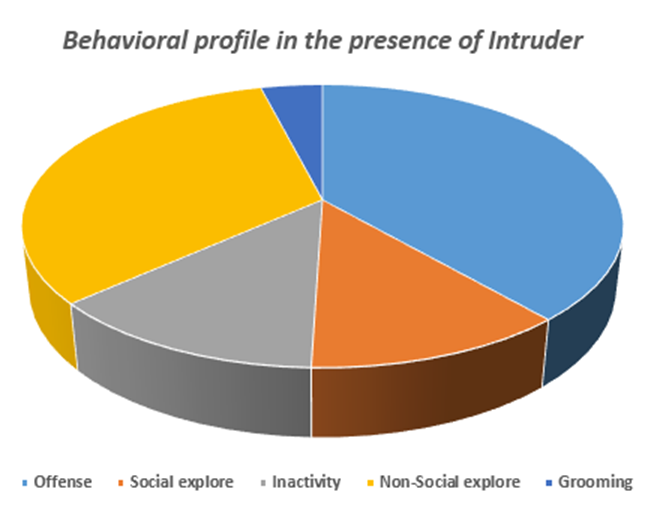
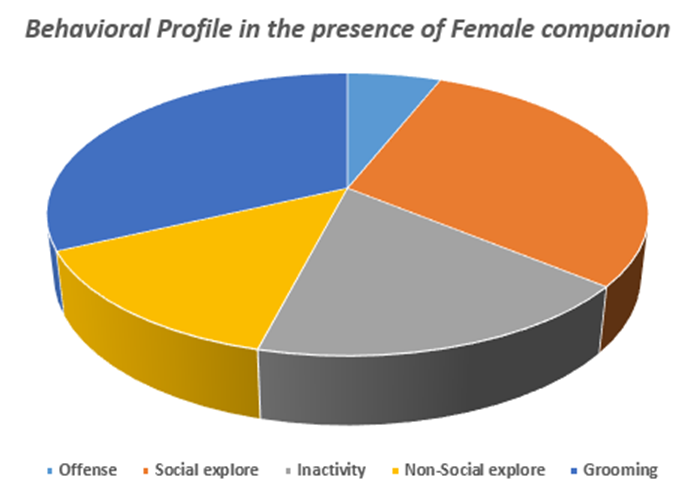
Another sample data can be visualized by plotting the relationship between vasopressin, serotonergic agonist and sham control as a function of attack latency and percentage offense. Vasopressin intensify dominance and aggression behaviors in rodents, whereas serotonergic agonist diminishes aggression behavior.
Strengths & Limitations
The resident intruder paradigm is simple and could be used to assess several aggressive behaviors both in the resident and intruder concurrently. It is also a tool to examine the level of social stress that occurs in the encounter between the resident and intruder. Another area of strength of the paradigm is that it has a very high predictive validity towards human aggression (Olivier and Young, 2001).
This model is an exceptional choice in screening for potential anti-aggressive drugs such as serenics.
The limitations that come with the use of this paradigm are in the fact that rats are subjected to unhealthy environment as beddings are not cleaned up for a week just to ensure that olfactory cues are not compromised. Also, during the test, some violent resident male may inflict injuries on the intruder.
However, despite these limitations, the resident-intruder paradigm allows robust studies on the causes, pattern and consequences of aggressive behavior. It is a model with a high face and construct validity that covers not only the adaptive biology of social behavior, but can be used to study maladaptive aspects as well in terms of violence and social stress pathology (Koolhaas et al., 2013).
Summary and Key Points
- The resident-intruder paradigm is a widely used model to assess aggressive behavior and its subsequent negative consequences such as social stress.
- It is a broadly applicable task as it can evaluate aggressive and defensive behaviors, social stress, the involvement of the HPA axis following social defeat, the effects of pro-aggressive and anti-aggressive drugs.
- The test is amendable and could be applied to gauge aggressive behavior in the subject under different situations and conditions.
- The task has a very high predictive validity towards human aggression and it is an exceptional choice in screening for potential anti-aggressive drugs such as serenics.
References
Albert, D.J., Dyson, E.M., Walsh, M.L., & Petrovic, D.M. Cohabitation with a female activates testosterone-dependent social aggression in male rats independently of changes in serum testosterone concentration. Physiology & Behavior. 44(6), 735-740 (1988).
Barnett SA.The rat: a study in behaviour.Chicago: University of Chicago Press, 1975.
de Boer, S.F . & Koolhaas, J.M. 5-HT1A and 5-HT1B receptor agonists and aggression: A pharmacological challenge of the serotonin deficiency hypothesis. European Journal of Pharmacology. 526(1-3), 125-139 (2005).
Koolhaas, J.M., Coppens, C.M., de Boer, S.F., Buwalda, B., Meerlo, P., Timmermans, P .J. The Resident-intruder Paradigm: A Standardized Test for Aggression, Violence and Social Stress. J. Vis. Exp. (77), e4367, doi: 10.3791/4367 (2013).
Miczek K A. A new test for aggression in rats without aversive stimulation: differential effects of D-amphetamine and cocaine. Psychopharmacology (Berl) 60:253–259 (1979)
Olivier, B. & Young, L. J. Chapter 118: Animal models of aggression. Neuropsychopharmacology: The Fifth Generation of Progress (2001).
De Miguel, Z., Vegas, O., Garmendia, L., Arregi, A., Beitia, G., & Azpiroz, A. Behavioral coping strategies in response to social stress are associated with distinct neuroendocrine, monoaminergic and immune response profiles in mice. Behavioural brain research, 225(2), 554–61 (2011)
Olivier B. Selective anti-aggresive properties of DU27725: ethological analyses of intermale and territorial aggression in the male rat. Pharmacol Biochem Behav 1981;14 [Suppl 1]:61–77.
Miczek KA, De Bold JF, Van Erp AM, et al. Alcohol, GABAAbenzodiazepine receptor complex, and aggression. Recent Dev Alcohol 1997; 13:139–171.
Ferris CF, Melloni RH, Koppel G, et al. Vasopressin/serotonin interactions in the anterior hypothalamus control aggressive behavior in golden hamsters. J Neurosci 1997;17:4331–4340

